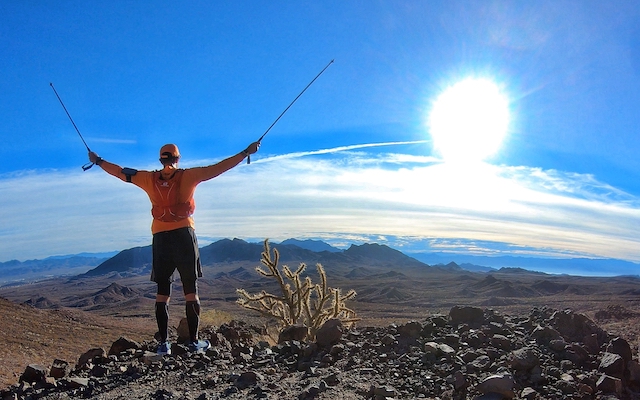
Today is the start of National Walking Month in the UK, but people with Parkinson’s all over Europe can get involved and enjoy the benefits of walking! Being active is one of the best ways to improve your Parkinson’s symptoms, and, for those with good mobility, walking is one of the easiest exercises you can do. It requires no special equipment (Nordic walking aside) – and you can do it in your garden, at your local park or simply by increasing your steps as you go about your daily life.
Four ways to get involved in National Walking Month – in the UK and beyond
- To celebrate National Walking Month in the UK, Parkinson’s UK is holding a 100 Mile Challenge, where people with and without the condition can get active and walk a total of 100 miles however they like within the month of May while fundraising for vital research into treatments and a cure for the condition. The organisation is also holding further Walk for Parkinson’s events across the UK from June to October.Tim Morton, Physical Activity Programme Lead at Parkinson’s UK, says: “Being physically active is as important as getting the right medication in helping to manage Parkinson’s symptoms, and walking is a great and accessible option for many people. Just 2.5 hours of activity a week can make a real difference to living well with the condition and have a positive impact physically, mentally, and socially.”
- Elsewhere in Europe, in northern Belgium Parkili.be is holding its annual spring walk on 25 May in Puyenbroeck park in Wachtebeke. You can sign up to walk 10 km or 5km, according to your ability.
- And wherever you are based, you can join in with the European Brain Foundation’s #Move4YrBrain campaign. Simply join their Strava group to share your walks – or runs – with them.
- Why not use National Walking Month as an excuse to look for Parkinson’s walking groups near you? Try contacting your local or national Parkinson’s organisation for help.
What walking does for me: Nordic walking
We spoke to some people with Parkinson’s about how walking has improved their health and wellbeing.
Mary Smith, from Brussels, was diagnosed with Parkinson’s 18 months ago. Since becoming aware of the benefits of exercise for the condition, the 81-year-old has made a concerted effort to increase the amount she walks, estimating that she has doubled the amount of walking she did before by walking to the shops and to appointments, amounting to about two hours a week. “If I walk and I don’t know the terrain or I know it’s rough, I will take a cane for balance,” she says.
A year ago, Mary also took up Nordic walking because of its benefits for people with Parkinson’s. Arranged by the Belgian organisation Action Parkinson ASBL, she does this at a central park once a week with a small group of other people with the condition. Asked if it helps improve her Parkinson’s symptoms, she says, “I can’t say specific symptoms, but in general it certainly helps my mood and helps me feel healthy and feel good. It improves my outlook and gives me energy.”

Christine, from the UK, is another person with Parkinson’s who can vouch for the benefits of Nordic walking, to the extent that she became an instructor and now runs two Nordic walking groups in the West Midlands.
“Nordic walking helps with posture, balance, coordination, cardio and overall fitness. Being outdoors helps you get more fresh air, feel good and manage your Parkinson’s. Most people with Parkinson’s can take part in Nordic walking, whatever stage they’re at in their journey,” she says.
“I really enjoy walking and catching up with others like myself. It gives me a real sense of hope! My biggest challenge is trying to walk as normally as I can, and checking my balance so I don’t fall.”
Stepping things up: hiking to the top of a mountain!

Although walking is an accessible everyday exercise for people with Parkinson’s, some people with the condition are putting one foot in front of the other to achieve incredible personal challenges while also helping to raise awareness and funds to battle the condition – and inspiring others with Parkinson’s to exercise. In October this year, 22 people with Parkinson’s will head to Nepal to trek to the top of the Himalayas – an altitude of 4,984 metres – in an expedition organised by Belgian Parkinson’s organisation Parkili.be.
Irishman Ian O’Brien, 44, who was diagnosed with Early Onset Parkinson’s at the age of 38, is another example of someone whose condition has led to him tackling an amazing feat: reaching the highest elevation point in each of the EU27 countries and the UK in just 28 days.
The idea came to him after climbing Ireland’s highest mountain Carrauntoohil, a surprise suggestion made by Ian’s physiotherapist friend after he told him he had been diagnosed with Parkinson’s.

“He said, ‘Come on, let’s go and climb Ireland’s highest mountain, Carrauntoohil.’ And I said, ‘All right.’ So, we climbed it, and I enjoyed it. It’s a tough climb. I was out of breath, and I was like, ‘What am I doing? I’ve bitten off too much here.’ And he encouraged me, and I got to the top and I was wrecked.”
It was a pivotal moment. “I always kind of look at it as like, ‘If I’ve got on the top of Ireland’s highest mountain, I can get on top of my diagnosis,’” says Ian.
“From there I developed a passion for hiking. You can stop, have a bite to eat, you can take in the scenery, it’s great to be out in nature as well – it ticks a lot of boxes without putting too much pressure on me,” says Ian, who is currently training to take part in the Edinburgh Marathon at the end of May, but normally goes hiking two or three times a week. “My favourite thing is when you can get to a place where you can’t see anything manmade, you can’t see anyone else, you’re looking around and you see mountains around you. I think it’s a nice feeling that you’re really with nature,” he says.
Last June, Ian, accompanied by some of his friends, set off to climb Europe’s 28 highest peaks in 28 days to help raise funds for Parkinson’s.
Despite training hard, Ian found parts of it particularly gruelling – he had to pull out of climbing the last 1,000 metres to the top of Mont Blanc in France because his guide was worried about his balance and safety when climbing back down. Reflecting on this now, he says, “Not getting to the top I think was part of the story. I have Parkinson’s; I can’t get away from it. I’m not Superman.”

Ian finished his 28-day challenge by climbing Carrauntoohil once more. It showed him that setting himself such a physical challenge could reap benefits. “The funny thing about it was I skipped up and down that mountain. It was amazing how my body had acclimatised. I proved a point that when you do excessive exercise and put your body through it that it can relearn and retrain, and my balance was so much better.”
Although he is planning to climb some of the mountains he tackled last year again this summer, he is aware that not all people with Parkinson’s will be able to do the same.
“I’m always conscious to say, ‘If you can’t get off the chair today and you do tomorrow, or you can’t walk down the hall in your house and you do tomorrow, that’s your mountain for the day. Don’t think that you need to go out and climb mountains; just go and do something that you couldn’t do yesterday.”
During National Walking Month and beyond, visit our sports hub for more inspiring stories about walking and running with Parkinson’s.



